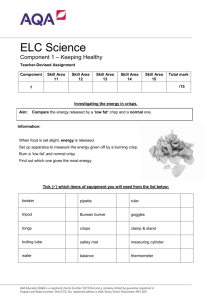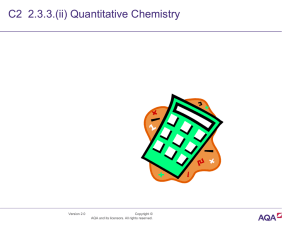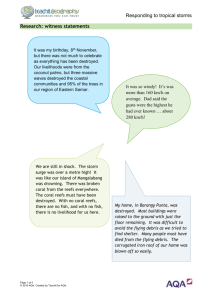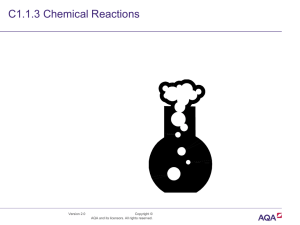4.2.3 National and global energy resources
advertisement
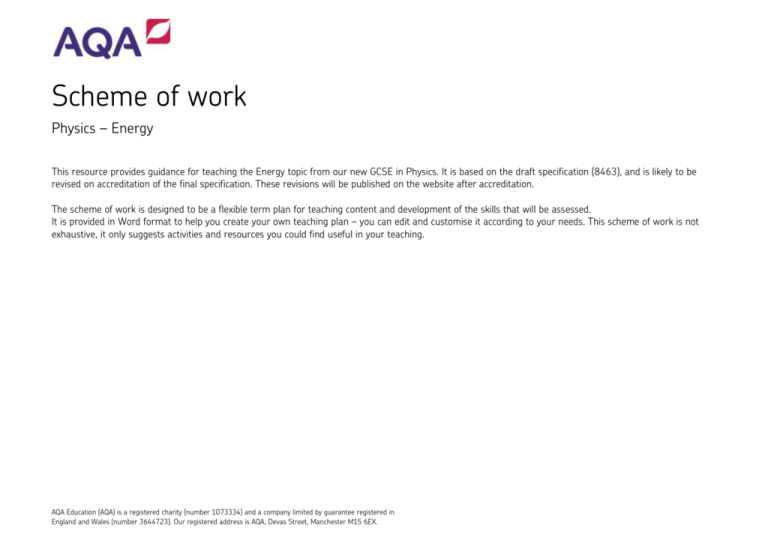
Scheme of work Physics – Energy This resource provides guidance for teaching the Energy topic from our new GCSE in Physics. It is based on the draft specification (8463), and is likely to be revised on accreditation of the final specification. These revisions will be published on the website after accreditation. The scheme of work is designed to be a flexible term plan for teaching content and development of the skills that will be assessed. It is provided in Word format to help you create your own teaching plan – you can edit and customise it according to your needs. This scheme of work is not exhaustive, it only suggests activities and resources you could find useful in your teaching. AQA Education (AQA) is a registered charity (number 1073334) and a company limited by guarantee registered in England and Wales (number 3644723). Our registered address is AQA, Devas Street, Manchester M15 6EX. 4.2 Energy 4.2.1 Energy changes in a system, and the ways energy is stored before and after such changes Spec ref. Summary of the specification content Learning outcomes What most students should be able to do Suggested timing (hours) Opportunities to develop Scientific Communication skills Opportunities to develop and apply practical and enquiry skills Self/peer assessment opportunities and resources Reference to past questions that indicate success 4.2.1.1 The changes involved in the way energy is stored when a system changes. A system is an object or group of objects. Describe, for common situations, the changes involved in the way energy is stored when a system changes. For example: an object projected upwards an object accelerated by a constant force a vehicle slowing down an electric kettle boiling water. 1 Presenting and writing descriptions and explanations: Obtaining and presenting primary evidence: Ask students to explore questions such as: Investigation using simple machines around a classroom/laboratory to look at changes in energy stores. Why are some kitchen appliances given higher energy ratings than others? Why do the wheels of a bike get very hot when braking hard? Which type of car is more efficient – petrol or electric? Describe the changes in energy stores that take place in simple machines and simple systems. Examples could include: petrol and electric cars vehicle braking systems (such as bike brakes) a ball being thrown upwards electrical items such as kettles and radios. AQA Education (AQA) is a registered charity (number 1073334) and a company limited by guarantee registered in England and Wales (number 3644723). Our registered address is AQA, Devas Street, Manchester M15 6EX. Compare three of the machines investigated showing their similarities and differences. Present the findings to the group. Energy types: BBC Bitesize – Forms of energy Cyberphysics – Energy Types BBC Bitesize – Energy transfers and efficiency Discuss energy wasted by the machines and ways to reduce it. Why does increasing the spring constant make a spring more difficult to stretch? Why does doubling the speed of a vehicle more than double the braking distance? 2 of 16 Spec ref. Summary of the specification content Learning outcomes What most students should be able to do Suggested timing (hours) Opportunities to develop Scientific Communication skills Opportunities to develop and apply practical and enquiry skills Self/peer assessment opportunities and resources Reference to past questions that indicate success 4.2.1.2 The amount of energy stored by an object can be calculated. Calculations to include kinetic energy, elastic potential energy and gravitational potential energy. Equations for kinetic energy and gravitational potential energy will not be given in the examination. Calculate the amount of energy stored by a moving object, a stretched spring and an object raised above ground level. The kinetic energy of a moving object can be calculated using the equation: 𝐾. 𝐸. = 0.5 𝑥 𝑚𝑎𝑠𝑠 𝑥 (𝑠𝑝𝑒𝑒𝑑)2 [𝐸𝐾 = 1 𝑚 𝑣2] 2 Kinetic energy, EK, in joules, J Mass, m, in kilograms, kg Speed, v, in metres per second, m/s The amount of elastic potential energy stored in a stretched spring can be calculated using the equation: 𝐸𝑙𝑎𝑠𝑡𝑖𝑐 𝑝𝑜𝑡𝑒𝑛𝑡𝑖𝑎𝑙 𝑒𝑛𝑒𝑟𝑔𝑦 = 0.5 𝑥 𝑠𝑝𝑟𝑖𝑛𝑔 𝑐𝑜𝑛𝑠𝑡𝑎𝑛𝑡 𝑥 (𝑒𝑥𝑡𝑒𝑛𝑠𝑖𝑜𝑛)2 2 Ask students to explore questions such as: Is all the gravitational potential energy stored in an object converted to a kinetic energy store by the object as it falls? Calculate: Calculate the amount of energy stored by various objects including moving objects, stretched springs and objects raised above the ground. Calculation of an object’s speed given the amount of kinetic energy stored by the object. Calculate the speed of an object, just before impact, when dropped from a given height by equating kinetic energy and gravitational potential energy. Presenting and writing descriptions and explanations: Explain the effect on the kinetic energy of an object when the speed and mass increases. In particular what will happen to the kinetic energy when the speed AQA Education (AQA) is a registered charity (number 1073334) and a company limited by guarantee registered in England and Wales (number 3644723). Our registered address is AQA, Devas Street, Manchester M15 6EX. Planning an approach. Selecting and managing variables: Find the amount of energy stored in a spring. Investigate the efficiency of an electric motor used to lift a load by calculating the energy input from the power of the motor x time. The energy stored by the object can be found using: 𝐸𝑝 = 𝑚 𝑔 ℎ Obtaining and presenting primary evidence: Investigations looking into finding the speed of a trolley that travels down a ramp. Calculate the g.p.e. at the top of the ramp and the kinetic energy at the bottom. Are they the same? Account for any differences that are observed. Gravitational potential energy: BBC Bitesize – Work and power Cyberphysics – Energy Types Kinetic energy: BBC Bitesize – Work and power Pass My Exams – Kinetic Energy Gravitational to kinetic energy transfers: BBC Bitesize – Work and power Cyberphysics – Energy Transfers Pass My Exams – Kinetic Energy (links to other types of energy, calculations that can be done using Mini White Boards) 3 of 16 Spec ref. Summary of the specification content Learning outcomes What most students should be able to do Suggested timing (hours) Opportunities to develop Scientific Communication skills Opportunities to develop and apply practical and enquiry skills Self/peer assessment opportunities and resources Reference to past questions that indicate success [𝐸𝑒 = 1 𝑘 𝑒 2] 2 (assuming the limit of proportionality has not been exceeded) elastic potential energy, Ee, in joules, J spring constant, k, in newtons per metre, N/m extension, e, in metres, m doubles and when the mass doubles? Application and implication: Explain the effect of increasing the spring constant of a spring on the ease that it stretches and on the amount of energy stored in the spring. The amount of gravitational potential energy gained by an object raised above the ground level can be calculated using the equation: 𝑔. 𝑝. 𝑒 = 𝑚𝑎𝑠𝑠 𝑥 𝑔𝑟𝑎𝑣𝑖𝑡𝑎𝑡𝑖𝑜𝑛𝑎𝑙 𝑓𝑖𝑒𝑙𝑑 𝑠𝑡𝑟𝑒𝑛𝑔𝑡ℎ 𝑥 ℎ𝑒𝑖𝑔ℎ𝑡 [𝐸𝑝 = 𝑚 𝑔 ℎ ] gravitational potential energy, Ep, in joules, J mass, m, in kilograms, kg gravitational field strength, g, in newtons per kilogram, N/kg AQA Education (AQA) is a registered charity (number 1073334) and a company limited by guarantee registered in England and Wales (number 3644723). Our registered address is AQA, Devas Street, Manchester M15 6EX. 4 of 16 Spec ref. Summary of the specification content Learning outcomes What most students should be able to do Suggested timing (hours) Opportunities to develop Scientific Communication skills Opportunities to develop and apply practical and enquiry skills Self/peer assessment opportunities and resources Reference to past questions that indicate success height, h, in metres, m 4.2.1.3 The way energy is stored in a system can change. This change can be calculated. The equations are covered in detail in sections 2.1 d-f. The specific heat capacity of a substance is the amount of energy required to change the temperature of one kilogram of the substance by one degree Celsius. 𝐸 = 𝑚 × 𝑐 × ө Calculate changes in the way energy is stored when a system is changed by: heating work done by forces work done when charge flows. Use calculations to show how the overall energy in a system is redistributed when the system is changed. The amount of energy stored in or released from a system as its temperature changes can be calculated using the equation: 𝐶ℎ𝑎𝑛𝑔𝑒 𝑖𝑛 𝑡ℎ𝑒𝑟𝑚𝑎𝑙 𝑒𝑛𝑒𝑟𝑔𝑦 = 𝑚𝑎𝑠𝑠 𝑥 𝑠𝑝𝑒𝑐𝑖𝑓𝑖𝑐 ℎ𝑒𝑎𝑡 𝑐𝑎𝑝𝑎𝑐𝑖𝑡𝑦 𝑥 𝑡𝑒𝑚𝑝𝑒𝑟𝑎𝑡𝑢𝑟𝑒 𝑐ℎ𝑎𝑛𝑔𝑒 [𝛥𝐸 = 𝑚 𝑐 𝛥𝜃] 2 Ask students to explore questions such as: Obtaining and presenting primary evidence: Design an experiment to compare the amount of energy transferred by a light bulb with the nominal rating given by the bulb (eg 12 W). Students would need to use 𝑄 = 𝐼𝑡 to find the charge flow. What determines how fast a material heats up? How is gravitational potential energy given to an object? Why does a flow of electrons along a wire allow bulbs to light and motors to spin? Presenting and writing descriptions and explanations: Describe how the energy stored in a system changes: when it is heated when a force does work when work is done when a charge flows. Calculate: Calculate the amount of work done when a force moves an object a distance perpendicular to the force applied. Calculate the increase in stored energy when a material is heated. AQA Education (AQA) is a registered charity (number 1073334) and a company limited by guarantee registered in England and Wales (number 3644723). Our registered address is AQA, Devas Street, Manchester M15 6EX. Why are concrete blocks used as thermal storage heaters? Why does a pan of oil heat faster than a pan of water? Why does the filling of a pie feel hotter than the pastry even though it has been in the same oven? Obtaining and presenting primary evidence. Required practical: GCSE Boardworks – Energy Efficiency, Energy and Movement (Mini White Boards for teacher’s Q&A or activities) Past Paper Questions Exampro ref: 1. Q14W.IP1.04 2. Q13W.1H.02 Kinetic energy: BBC Bitesize – Specific heat capacity Video clip YouTube: GCSE Science Revision – Specific Heat Capacity Investigation to measure the specific heat capacity of one or more materials. The investigation will involve 5 of 16 Spec ref. Summary of the specification content Learning outcomes What most students should be able to do Suggested timing (hours) Opportunities to develop Scientific Communication skills Opportunities to develop and apply practical and enquiry skills Self/peer assessment opportunities and resources Reference to past questions that indicate success change in thermal energy, ΔE, in joules, J mass, m, in kilograms, kg specific heat capacity, c, in joules per kilogram per degree Celsius, J/kg°C temperature change, Δθ, in degrees Celsius, °C The specific heat capacity of a substance is the amount of energy required to raise the temperature of one kilogram of the substance by one degree Celsius. Students should carry out an investigation to measure the specific heat capacity of one or more materials. The investigation will involve linking the decrease of one energy store to the increase in thermal energy stored. Calculate the energy transferred when a charge flows across a potential difference. Presenting and writing descriptions and explanations: Describe what is happening at an atomic level when a substance is being heated. Developing explanations using ideas and models: Give students an opportunity to create their own models to explain what is happening when a solid is being heated. This can be in the form of a diagram, a 2D or 3D model as they see fit. Calculate: Carry out calculations involving specific heat capacity. Students should also be able to rearrange the equation to find any unknown in the equation. Presenting and writing arguments: Evaluate the use of concrete in storage heaters: Why is concrete used? AQA Education (AQA) is a registered charity (number 1073334) and a company limited by guarantee registered in England and Wales (number 3644723). Our registered address is AQA, Devas Street, Manchester M15 6EX. linking the decrease of one energy store (or work done) to the increase in temperature and subsequent increase in thermal energy stored. (P2.1d) In measuring specific heat capacity students will have to measure energy or work done, this could be loss of g.p.e., electrical work (VIt) and the change in thermal energy. This may be better moved to section 6.6.2b when all of the preliminary work has been completed. Working critically with primary and secondary evidence: How much energy is in a crisp? Do some research to find out the published figures and then investigate it. Working scientifically: Research different methods for measuring specific heat capacity. 6 of 16 Spec ref. Summary of the specification content Learning outcomes What most students should be able to do Suggested timing (hours) Opportunities to develop Scientific Communication skills Opportunities to develop and apply practical and enquiry skills Self/peer assessment opportunities and resources Reference to past questions that indicate success What are the problems associated with the use of concrete? Why aren’t other materials with a higher or lower specific heat capacity used? AQA Education (AQA) is a registered charity (number 1073334) and a company limited by guarantee registered in England and Wales (number 3644723). Our registered address is AQA, Devas Street, Manchester M15 6EX. Design safe practical procedures that allow data to be collected. Select suitable apparatus for carrying out the experiment accurately and safely. Identify possible hazards, the risks associated with these hazards, and methods of minimising the risks. Make measurements with appropriate precision and record data in appropriate tables. Evaluate data and working methods. Recognise random and systematic errors; identify their causes. Identify causes of uncertainty in final calculated values and suggest ways of reducing the inaccuracies to improve the accuracy of the calculated values. 7 of 16 Spec ref. Summary of the specification content Learning outcomes What most students should be able to do Suggested timing (hours) Opportunities to develop Scientific Communication skills Opportunities to develop and apply practical and enquiry skills Self/peer assessment opportunities and resources Reference to past questions that indicate success 4.2.1.4 The work done on an object is determined by the size of the force that acts on it and the displacement that the application of the force produces. The amount of energy transferred by electrical work is determined by the flow of charge and the potential difference. A force does work on an object when the force causes a displacement of the object: 𝑊𝑜𝑟𝑘 𝑑𝑜𝑛𝑒 = 𝑓𝑜𝑟𝑐𝑒 𝑥 𝑑𝑖𝑠𝑡𝑎𝑛𝑐𝑒 (𝑎𝑙𝑜𝑛𝑔 𝑡ℎ𝑒 𝑙𝑖𝑛𝑒 𝑜𝑓 𝑎𝑐𝑡𝑖𝑜𝑛 𝑜𝑓 𝑡ℎ𝑒 𝑓𝑜𝑟𝑐𝑒) [𝑊 = 𝑓 𝑥 𝑑] work done, W, in joules, J force, F, in newtons, N distance, d, in metres, m Work is done when charge flows in a circuit. The amount of energy transferred by electrical work can be calculated using the equation: 𝐸𝑛𝑒𝑟𝑔𝑦 𝑡𝑟𝑎𝑛𝑠𝑓𝑒𝑟𝑟𝑒𝑑 = 𝑐ℎ𝑎𝑟𝑔𝑒 𝑓𝑙𝑜𝑤 𝑥 𝑝𝑜𝑡𝑒𝑛𝑡𝑖𝑎𝑙 𝑑𝑖𝑓𝑓𝑒𝑟𝑒𝑛𝑐𝑒 [𝐸 = 𝑄 𝑥 𝑉] energy transferred, E, in joules, J charge flow, Q, in 1 Ask students to explore questions such as: Obtaining and presenting primary evidence: Pass My Exams – Work & Energy Why do some appliances cost more to run than others? Why are energy saving light bulbs cheaper to run than filament bulbs when they are connected to the same electricity supply? Plan and carry out an investigation to find the amount of electrical energy transferred when various electrical appliances are in use. This should be restricted to appliances that can be run from standard laboratory power supply units so that an ammeter can be connected. Use 𝑄 = 𝐼𝑡 to find the charge flow. GCSE Boardworks – Work and Power Section Calculate: Carry out calculations to determine the work done when a force displaces an object. Students are required to rearrange the equation. Mini White Boards based on teacher’s own questions or Boardworks activities. Past Paper Questions Exampro ref: Developing explanations using ideas and models: 1. Q13S.2F.04 Use a diagram to model a real situation and to calculate the work done by a force. 3. Q10SY2F01 2. Q12WY2F01 Presenting and writing descriptions and explanations: S-cool, the revision website – Work and Energy (animations) Describe and explain what is happening in terms of changes in energy stores when a motor is used to raise a lift. Kinetic energy: BBC Bitesize – Work, force and distance Calculations: AQA Education (AQA) is a registered charity (number 1073334) and a company limited by guarantee registered in England and Wales (number 3644723). Our registered address is AQA, Devas Street, Manchester M15 6EX. 8 of 16 Spec ref. Summary of the specification content Learning outcomes What most students should be able to do Suggested timing (hours) Opportunities to develop Scientific Communication skills Opportunities to develop and apply practical and enquiry skills Self/peer assessment opportunities and resources Reference to past questions that indicate success coulombs, C potential difference, V, in volts, V Carry out calculations to determine the amount of electrical energy transferred when there is a flow of charge across a potential difference. Students are required to rearrange the equation. Presenting and writing descriptions and explanations: Explain why different electrical items plugged into mains electricity cost different amounts to run even if they are on for the same amount of time. 4.2.1.5 The power rating of an appliance states how much energy is being transferred or the rate at which work is done. Power is defined as the rate at which energy is transferred or the rate at which work is done. 𝑃𝑜𝑤𝑒𝑟 = 𝑒𝑛𝑒𝑟𝑔𝑦 𝑡𝑟𝑎𝑛𝑠𝑓𝑒𝑟𝑟𝑒𝑑 𝑇𝑖𝑚𝑒 [𝑃 = 𝐸 / 𝑡] 𝑃𝑜𝑤𝑒𝑟 = 𝑤𝑜𝑟𝑘 𝑑𝑜𝑛𝑒 𝑇𝑖𝑚𝑒 [𝑃 = 𝑊 / 𝑡] 1 Applications, implications and cultural understanding. Developing argument: Evaluate the benefits and drawbacks of using lower power devices such as compact fluorescent lamps (CFLs). Calculations: Carry out calculations to determine power, using energy transferred divided by time and work done divided by time. Planning an approach: Investigating power. Find out how much power students have by getting them to perform simple tasks. Examples could include walking up a flight of stairs, lifting masses up a known height and pulling an object across a floor. For each case the students need to know the work done and the time taken. Work done: BBC Bitesize – Work and power Power, P, in watts, W AQA Education (AQA) is a registered charity (number 1073334) and a company limited by guarantee registered in England and Wales (number 3644723). Our registered address is AQA, Devas Street, Manchester M15 6EX. 9 of 16 Spec ref. Summary of the specification content Learning outcomes What most students should be able to do Suggested timing (hours) Opportunities to develop Scientific Communication skills Opportunities to develop and apply practical and enquiry skills Self/peer assessment opportunities and resources Reference to past questions that indicate success Energy transferred, E, in joules, J Obtaining and presenting primary evidence: Time, t, in seconds, s Is mechanical power the same as electrical power? Work done, W, in joules, J An energy transfer of one joule per second is equal to a power of 1 watt. AQA Education (AQA) is a registered charity (number 1073334) and a company limited by guarantee registered in England and Wales (number 3644723). Our registered address is AQA, Devas Street, Manchester M15 6EX. Demonstrate measuring the energy transferred to a low voltage motor as it lifts a load. Compare it to the gravitational potential energy gained by the load. 10 of 16 4.2.2 Conservation and dissipation of energy Spec ref. Summary of the specification content Learning outcomes What most students should be able to do Suggested timing (hours) Opportunities to develop Scientific Communication skills Opportunities to develop and apply practical and enquiry skills Self/peer assessment opportunities and resources Reference to past questions that indicate success 4.2.2.1 The total amount of energy in a system remains constant though the way the energy is stored in the system can change. The energy transfers in a system are not always useful. Energy that is transferred in a way that is not considered useful is often described as being wasted. Reducing unwanted energy transfers. Reducing heat loss from a home by use of insulation. Energy can be transferred usefully, stored or dissipated, but cannot be created or destroyed. Describe examples where there are energy transfers in a closed system, that there is no net change to the total energy. Whenever there are energy transfers in a system only part of the energy is usefully transferred. The rest of the energy is dissipated so that it is stored in less useful ways. This energy is often described as being wasted. Unwanted energy transfers can be reduced in a number of ways, for example, through lubrication and the use of thermal insulation. Describe how the rate of cooling of a building is 2 Ask students to explore questions such as: Working critically with primary and secondary evidence: What is the best type of insulation to use in the home? YouTube: GCSE BBC Bitesize Revision Physics 5 Energy Transfer 2 Plan and carry out an investigation to find out which type of insulation will reduce heat loss the most. YouTube: How to insulate Your Home: Types of Loft Insulation Investigate how the thickness of the insulating material used affects heat loss. Episodes of ’Grand Designs’ may get students thinking about the design of buildings and insulation. Good examples include: Can energy be created or destroyed? What happens to energy that is lost? How can we reduce the amount of energy being wasted by a machine? What is the best way to reduce heat loss in the home? Presenting and writing descriptions and explanations: Describe what happens to the electrical energy that goes into an appliance, such as a radio – in terms of energy stores and how the amount of energy in each store changes. Presenting and writing arguments: Evaluate the use of various types of insulation in the home. Look in particular at the effectiveness of loft insulation, double glazing and cavity wall insulation. The AQA Education (AQA) is a registered charity (number 1073334) and a company limited by guarantee registered in England and Wales (number 3644723). Our registered address is AQA, Devas Street, Manchester M15 6EX. Required practical: Investigate ways of reducing the unwanted energy transfers in a system. (P2.2a) This could be a straightforward investigation of insulation or maybe effect of lubrication. Obtaining and presenting primary evidence: Design a building that will Video clips YouTube: Grand Designs – S9E09 The Cambridgeshire Eco Home Cambridgeshire Revisited YouTube: Grand Designs Australia 11 of 16 Spec ref. Summary of the specification content Learning outcomes What most students should be able to do Suggested timing (hours) Opportunities to develop Scientific Communication skills Opportunities to develop and apply practical and enquiry skills Self/peer assessment opportunities and resources Reference to past questions that indicate success affected by the thickness and thermal conductivity of its walls. The higher the thermal conductivity of a material, the higher the rate of energy transfer by conduction across the material. Students should investigate ways of reducing the unwanted energy transfers in a system. evaluation could be based on cost, U-value, thermal conductivity, payback time or lifetime of the insulation fitted. Communication for audience and purpose: Design a poster to illustrate the reasons why insulating the home is beneficial for both the homeowner and the environment. Select specific examples and suggest what could happen if insulation was not used in the home. have very low heating bills. This can be a 2D or 3D model – it is possible using a beaker of hot water and a thermometer to find out how effective the insulation is in a 3D model that has been built. Investigate ways of reducing the energy loss in a rollercoaster – so that a marble dropped down a Ushaped track will roll higher up the opposite side of the track. – S04E06 Forest Lodge Eco [Full Episode] Energy changes that take place in a rollercoaster: BBC Bitesize – Gravitational potential energy Pass My Exams – Conservation of Energy & Energy Transfer Boardworks – very good sections on this topic and activities which can be done using Mini White Boards. Past Paper Questions Exampro ref: 1. Q13W.1F.09 2 Q12W1H06 3. Q10SW1F04 4. Q07S.1F.03 5. Q07S.1H.06 6. QSB02.2.04 AQA Education (AQA) is a registered charity (number 1073334) and a company limited by guarantee registered in England and Wales (number 3644723). Our registered address is AQA, Devas Street, Manchester M15 6EX. 12 of 16 Spec ref. Summary of the specification content Learning outcomes What most students should be able to do Suggested timing (hours) Opportunities to develop Scientific Communication skills Opportunities to develop and apply practical and enquiry skills Self/peer assessment opportunities and resources Reference to past questions that indicate success 4.2.2.2 Calculating efficiency. How to increase efficiency. The energy efficiency for any energy transfer can be calculated using the equation: 𝑒𝑓𝑓𝑖𝑐𝑖𝑒𝑛𝑐𝑦 = 𝑢𝑠𝑒𝑓𝑢𝑙 𝑜𝑢𝑡𝑝𝑢𝑡 𝑒𝑛𝑒𝑟𝑔𝑦 𝑡𝑟𝑎𝑛𝑠𝑓𝑒𝑟 𝑡𝑜𝑡𝑎𝑙 𝑖𝑛𝑝𝑢𝑡 𝑒𝑛𝑒𝑟𝑔𝑦 𝑡𝑟𝑎𝑛𝑠𝑓𝑒𝑟 Describe ways to increase the efficiency of an intended energy transfer. 1 Ask students to explore questions such as: Which type of power station is the most efficient? Which type of light bulb would cost the least amount of money to use? Research different types of power station to find out if combustion based power stations are less efficient that either nuclear or wind. Investigate ways of increasing the efficiency of a coal fired power station. Prepare a presentation on different types of light bulb. Find out the cost of buying and running the light bulbs in a home for one year. Determine whether energy saving light bulbs will save money over incandescent light bulbs. State the equation used to find efficiency. Calculate the efficiency of a machine as either a decimal or a AQA Education (AQA) is a registered charity (number 1073334) and a company limited by guarantee registered in England and Wales (number 3644723). Our registered address is AQA, Devas Street, Manchester M15 6EX. Energy efficiency calculations: BBC Bitesize – Efficiency Efficiency of power stations video clip: YouTube: Which Power Source Is most Efficient? Pass My Exams – Energy Transfer Diagrams and Efficiency Cyberphysics – Sankey diagrams GCSE Boardworks – Energy & Efficiency section Mini White Boards based on teacher’s own questions or activities from Boardworks Past Paper Questions Exampro ref: 13 of 16 Spec ref. Summary of the specification content Learning outcomes What most students should be able to do Suggested timing (hours) Opportunities to develop Scientific Communication skills Opportunities to develop and apply practical and enquiry skills Self/peer assessment opportunities and resources Reference to past questions that indicate success percentage. Rearrange the equation to determine the total energy put into the machine or the useful energy output. 1. Q14W.IP1.04 2. Q14S.1F.01 3. Q13S.1F.07 4. Q13W.1F.02 Students may have to analyse data to determine the useful energy output if they are told the energy input and the amount of wasted energy. Interpret data on efficiencies of different machines. AQA Education (AQA) is a registered charity (number 1073334) and a company limited by guarantee registered in England and Wales (number 3644723). Our registered address is AQA, Devas Street, Manchester M15 6EX. 14 of 16 4.2.3 National and global energy resources Spec ref. Summary of the specification content Learning outcomes What most students should be able to do Suggested timing (hours) Opportunities to develop Scientific Communication skills Opportunities to develop and apply practical and enquiry skills Self/peer assessment opportunities and resources Reference to past questions that indicate success 4.2.3 Energy Resources. Renewable and non-renewable energy resources. Describe the main energy resources available for use on Earth. These include: fossil fuels (coal, oil and gas) nuclear fuel bio-fuel wind hydro-electricity geothermal the tides the Sun water waves. Distinguish between energy resources that are renewable and energy resources that are nonrenewable. Compare the ways that different energy resources are used. The uses to include transport, electricity generation and heating. 1 Define renewable energy resource and give examples of them. Define non-renewable energy resource and give examples of them. Explain the advantages and disadvantages of each type of energy resource with respect to other sources, eg the advantages and disadvantages of coal over nuclear power. Research the different types of energy resources that are available to generate electricity. For each type of energy resource find the environmental impacts. Explain why each type of energy resource is used to generate electricity even though it does have these environmental impacts. For a given location determine the best way of generating electricity. Investigations into output of a model wind turbine or solar cell. S-cool, the revision website – Non-renewable Energy Sources Cyberphysics – Energy Resources The Energy Story – Chapter 20: Hydrogen and Future Energy Sources Pass My Exams – Electricity Generation Video clip YouTube: Energy Resources GCSE Boardworks – Non Renewable, Renewable sections Role-play a meeting between a Mini White Boards AQA Education (AQA) is a registered charity (number 1073334) and a company limited by guarantee registered in England and Wales (number 3644723). Our registered address is AQA, Devas Street, Manchester M15 6EX. 15 of 16 Spec ref. Summary of the specification content Learning outcomes What most students should be able to do Suggested timing (hours) Opportunities to develop Scientific Communication skills Opportunities to develop and apply practical and enquiry skills Self/peer assessment opportunities and resources Reference to past questions that indicate success group of local councillors/MPs, local environmental groups and electricity companies trying to get a new power station built. Which type of power station would each group want? How persuasive are each group in getting their choice? Evaluate the use of different energy resources for a given situation, eg generating electricity in remote locations. The evaluation should include ethical and environmental issues. based on teacher’s own questions or activities from Boardworks Past Paper Questions Exampro ref: 1. Q13W.Y1H.06 2. QSP.1F.02 3. QB04.F.03 4. QCJ95R9.02 5. Q14S.1F.04 Compare the use of different fuels in the generation of electricity, heating homes and transport. Determine the most suitable fuel for a particular use depending on the characteristics of the fuel. Identify the political, social, ethical and economic considerations of choosing fossil fuels or nuclear fuels to generate electricity. AQA Education (AQA) is a registered charity (number 1073334) and a company limited by guarantee registered in England and Wales (number 3644723). Our registered address is AQA, Devas Street, Manchester M15 6EX. 16 of 16



